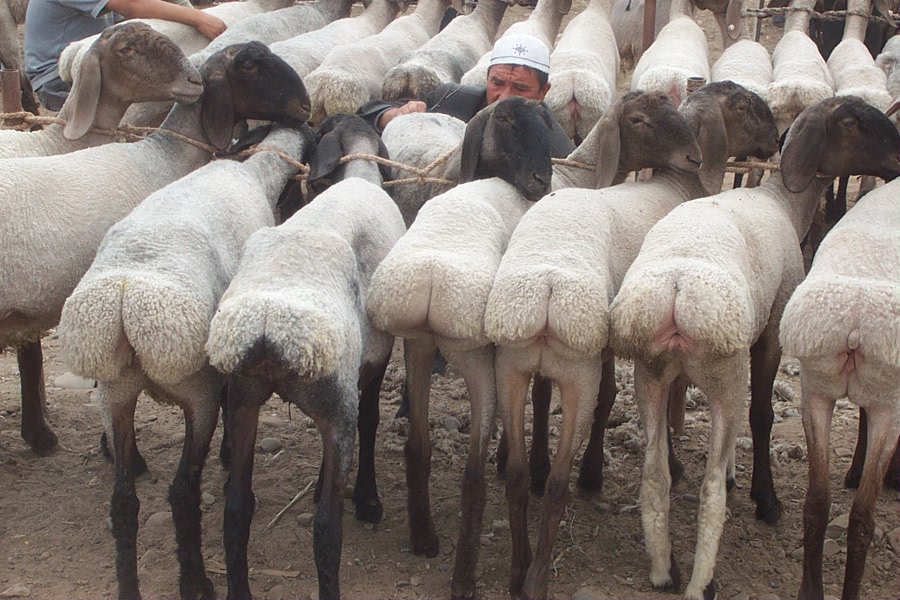Tail Fat on:
[Wikipedia]
[Google]
[Amazon]

 Tail fat is the fat of some breeds of
Tail fat is the fat of some breeds of

 Tail fat is the fat of some breeds of
Tail fat is the fat of some breeds of sheep
Sheep (: sheep) or domestic sheep (''Ovis aries'') are a domesticated, ruminant mammal typically kept as livestock. Although the term ''sheep'' can apply to other species in the genus '' Ovis'', in everyday usage it almost always refers to d ...
, especially of fat-tailed sheep. It is fat accumulated in baggy deposits in the hind parts of a sheep on both sides of its tail and on the first 3–5 vertebrae of the tail. These hind parts are used to accumulate fat for subsequent use during dry seasons, similar to a camel
A camel (from and () from Ancient Semitic: ''gāmāl'') is an even-toed ungulate in the genus ''Camelus'' that bears distinctive fatty deposits known as "humps" on its back. Camels have long been domesticated and, as livestock, they provid ...
's humps.
It is known under the name kurdyuk in Russian
Russian(s) may refer to:
*Russians (), an ethnic group of the East Slavic peoples, primarily living in Russia and neighboring countries
*A citizen of Russia
*Russian language, the most widely spoken of the Slavic languages
*''The Russians'', a b ...
and in Central Asian
Central Asia is a region of Asia consisting of Kazakhstan, Kyrgyzstan, Tajikistan, Turkmenistan, and Uzbekistan. The countries as a group are also colloquially referred to as the "-stans" as all have names ending with the Persian language, Pers ...
languages, from the proto-Turkic
Proto-Turkic is the linguistic reconstruction of the common ancestor of the Turkic languages that was spoken by the Proto-Turks before their divergence into the various Turkic peoples. Proto-Turkic separated into Oghur (western) and Common Tu ...
''*kudruk'' 'tail'.
Tail fat is known in Arabic
Arabic (, , or , ) is a Central Semitic languages, Central Semitic language of the Afroasiatic languages, Afroasiatic language family spoken primarily in the Arab world. The International Organization for Standardization (ISO) assigns lang ...
as ''لية'', (''leeyeh'', ''leyyah'', or ''layeh''), ''zaaka'' in Algeria, '' kuyruk yağı'' 'tail fat' in Turkish, and دنبه 'donbe'' or ''dombe' in Iran, אַלְיָה (''Alya'') in Hebrew, words which may be found in ancient texts as well as in local food culture and in sheep breeds' names.
The rendered tail fat does not solidify at room temperature and is used in cuisine. Cracklings
Cracklings (American English), crackling (British English), also known as scratchings, are the solid material that remains after Rendering (animal products), rendering animal fat and skin to produce lard, tallow, or schmaltz, or as the result of ro ...
left after the rendering or frying of ''kurdyuk'' may be used as an appetizer
An hors d'oeuvre ( ; ), appetiser, appetizer or starter is a small dish served before a meal in European cuisine. Some hors d'oeuvres are served cold, others hot. Hors d'oeuvres may be served at the dinner table as a part of the meal, or th ...
. When being rendered, kurdyuk emits a strong odour, described as "acidy-poisonous". However, it has a rich flavor when ready to eat. In particular it is used to cook kofta
Kofta is a family of meatball or meatloaf dishes found in South Asian, Central Asian, Balkan, Middle Eastern, North African, and South Caucasian cuisines. In the simplest form, koftas consist of balls of minced meat—usually beef, chicken, ...
, pilav, and other traditional dishes.
References
{{fatsandoils Meat Sheep Animal fat products Cooking fats